
CURATOR’s EYE
3 minutes Art -Aniko Hencz-
Follow TRiCERA on Instagram and check out our creative artists
5%OFF & free shipping 1st purchase
FIRSTART5
10%OFF 2nd purchase after 1st purchase!
Welcome to TRiCERA
Hi there! We are pleased to have you here 🎉
Could you please describe yourself?
Guest
Born in Paris in 1840, Claude Monet was a leading Impressionist painter.
He is known as an experimental painter who practiced the technique of serial painting, in which the same motif is repeated many times in different time periods. This technique made Monet's paintings luminous and lively.
In this issue, let's learn what Monet accomplished in 10 chapters.
The term "Impressionism" derives from the title of the painting "Impression, Sunrise," which Monet and his associates exhibited at the first independent exhibition held in 1874 in place of the Salon.
Louis Leroy, a humorist active in France at the time, began referring to the group as "Impressionists" to make fun of them.
Leroy criticized the first Impressionist exhibition by titling it "The Impressionist Exhibition," but curiously enough, it was later acclaimed and ultimately made the art movement famous.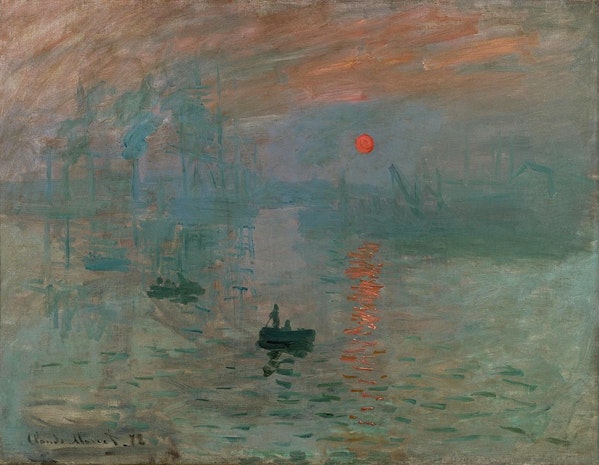
Impression, Sunrise, 1872
Monet began working in 1883 in Giverny, a small village down the Seine River from Paris.
Then, in 1893, he purchased the land in front of his house and built a Japanese garden in the space. He created a large pond using the stream that runs through the property, and built a drum bridge over it. He planted water lilies, willow trees, and shrubs in the pond, and closed himself off from the outside world in a world of water to create his final series of works, "Water Lilies.
He built a glass-walled studio beside the garden and installed an easel with wheels that could be rolled freely, allowing him to move freely around the room.
There he created a series of images of the pond, water lilies, and reflected light that changed with the time of day, morning, noon, and night.
In this series, he painted willows along the shore, a drum bridge, the sky at dusk, and many other images.
However, he eventually concentrated on depicting the ponds themselves.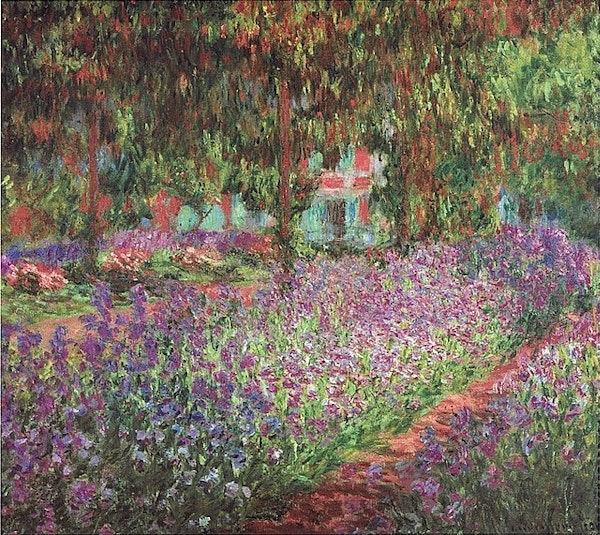
The Painter's Garden at Giverny, 1900.
Not only did Monet use Japanese landscaping styles as references, but he was also greatly influenced by Japanese art in terms of subject matter and painting techniques.
For example, the image below is a woodblock print by Utagawa Hiroshige.
Did you see anything similar in Monet's painting?
Japanese color woodblock prints created by Utagawa Hiroshige and others show a detailed close-up of purple wisteria flowers gracefully dispersing along the pillars beyond an arched bridge, which inspired the artist's painting of the Water Lily Garden at Giverny.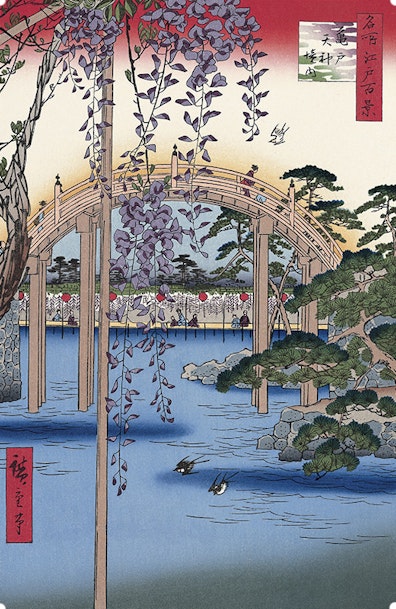
Utagawa Hiroshige|The precincts of Kameido Tenjin Shrine
While his reputation and fame grew, Monet was also often plagued by financial hardships.
In 1868, shortly after the birth of his first son, Jean, Monet became increasingly frustrated with his financial situation and attempted suicide by throwing himself into the Seine River.
Fortunately, this time he failed, but it was not the last misfortune Monet faced.
In 1876, during his second pregnancy, his wife Camille became ill and died in 1879 at the age of 32.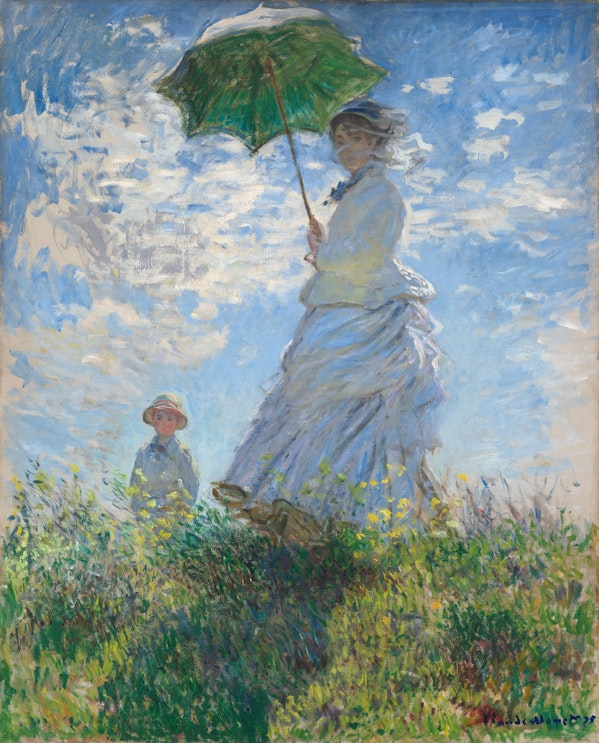
Woman with a Parasol: The Painter's Wife and Son, 1875
Monet had a profound influence on modern artists such as Roy Lichtenstein.
Lichtenstein was an American Pop Art painter who, along with Andy Warhol and others, became a major force in the art world.
This work, "Red Barn," follows Lichtenstein's famous "Haystack" and "Cathedral" series, which Lichtenstein himself called "Monet reproduced.
Between 1969 and 1993, Lichtenstein produced a series of over 20 prints similar to Monet's of the same motif.
Roy Lichtenstein, "Red House," 1969.
In fact, Monet had a special room in the museum designed just for his famous late work, the "Waterlilies" series.
Did you know that you can also look around the room via Google Street View?
Dedicated by Claude Monet to the French nation as a symbol of peace the day after the Armistice on November 11, 1918, the Waterlilies were installed in the Musée de l'Orangerie in 1927, a few months after his death, according to his plan.
Today, this oval room, known as the "Waterlilies Room" in the Musee de l'Orangerie, offers visitors an immersive experience as if they were one with the world of the painting, and has become a very popular spot in Paris, a city that is crowded with some of the best museums in the world.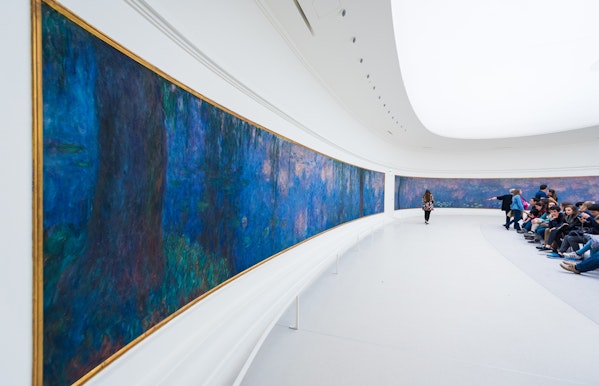
The Monet Room at the Musée de l'Orangerie
View TRiCERA ART's latest works
TRiCERA ART members enjoy a variety of privileges and preferences.
- Discounts, including members-only secret sales and coupons
- Create your own collection by registering your favorite artists
- Receive updates on popular artists, exhibitions, and events
- Receive a weekly newsletter with selected art
- Personal Assessment to find out what kind of art you like.
Please register as a member for free and receive the latest information.

Writer
TRiCERA ART
Born in Paris in 1840, Claude Monet was a leading Impressionist painter.
He is known as an experimental painter who practiced the technique of serial painting, in which the same motif is repeated many times in different time periods. This technique made Monet's paintings luminous and lively.
In this issue, let's learn what Monet accomplished in 10 chapters.
The term "Impressionism" derives from the title of the painting "Impression, Sunrise," which Monet and his associates exhibited at the first independent exhibition held in 1874 in place of the Salon.
Louis Leroy, a humorist active in France at the time, began referring to the group as "Impressionists" to make fun of them.
Leroy criticized the first Impressionist exhibition by titling it "The Impressionist Exhibition," but curiously enough, it was later acclaimed and ultimately made the art movement famous.
Impression, Sunrise, 1872
Monet began working in 1883 in Giverny, a small village down the Seine River from Paris.
Then, in 1893, he purchased the land in front of his house and built a Japanese garden in the space. He created a large pond using the stream that runs through the property, and built a drum bridge over it. He planted water lilies, willow trees, and shrubs in the pond, and closed himself off from the outside world in a world of water to create his final series of works, "Water Lilies.
He built a glass-walled studio beside the garden and installed an easel with wheels that could be rolled freely, allowing him to move freely around the room.
There he created a series of images of the pond, water lilies, and reflected light that changed with the time of day, morning, noon, and night.
In this series, he painted willows along the shore, a drum bridge, the sky at dusk, and many other images.
However, he eventually concentrated on depicting the ponds themselves.
The Painter's Garden at Giverny, 1900.
Not only did Monet use Japanese landscaping styles as references, but he was also greatly influenced by Japanese art in terms of subject matter and painting techniques.
For example, the image below is a woodblock print by Utagawa Hiroshige.
Did you see anything similar in Monet's painting?
Japanese color woodblock prints created by Utagawa Hiroshige and others show a detailed close-up of purple wisteria flowers gracefully dispersing along the pillars beyond an arched bridge, which inspired the artist's painting of the Water Lily Garden at Giverny.
Utagawa Hiroshige|The precincts of Kameido Tenjin Shrine
While his reputation and fame grew, Monet was also often plagued by financial hardships.
In 1868, shortly after the birth of his first son, Jean, Monet became increasingly frustrated with his financial situation and attempted suicide by throwing himself into the Seine River.
Fortunately, this time he failed, but it was not the last misfortune Monet faced.
In 1876, during his second pregnancy, his wife Camille became ill and died in 1879 at the age of 32.
Woman with a Parasol: The Painter's Wife and Son, 1875
Monet had a profound influence on modern artists such as Roy Lichtenstein.
Lichtenstein was an American Pop Art painter who, along with Andy Warhol and others, became a major force in the art world.
This work, "Red Barn," follows Lichtenstein's famous "Haystack" and "Cathedral" series, which Lichtenstein himself called "Monet reproduced.
Between 1969 and 1993, Lichtenstein produced a series of over 20 prints similar to Monet's of the same motif.
Roy Lichtenstein, "Red House," 1969.
In fact, Monet had a special room in the museum designed just for his famous late work, the "Waterlilies" series.
Did you know that you can also look around the room via Google Street View?
Dedicated by Claude Monet to the French nation as a symbol of peace the day after the Armistice on November 11, 1918, the Waterlilies were installed in the Musée de l'Orangerie in 1927, a few months after his death, according to his plan.
Today, this oval room, known as the "Waterlilies Room" in the Musee de l'Orangerie, offers visitors an immersive experience as if they were one with the world of the painting, and has become a very popular spot in Paris, a city that is crowded with some of the best museums in the world.
The Monet Room at the Musée de l'Orangerie
View TRiCERA ART's latest works
TRiCERA ART members enjoy a variety of privileges and preferences.
- Discounts, including members-only secret sales and coupons
- Create your own collection by registering your favorite artists
- Receive updates on popular artists, exhibitions, and events
- Receive a weekly newsletter with selected art
- Personal Assessment to find out what kind of art you like.
Please register as a member for free and receive the latest information.

Writer
TRiCERA ART